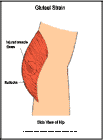
Gluteal Strain
What is a gluteal strain?
Your gluteal muscles are the muscles in your buttocks. A strained muscle is when the muscle fibers are stretched or torn.
How does it occur?
A gluteal strain usually occurs with running or jumping. It is often seen in hurdlers or dancers.
What are the symptoms?
A gluteal strain causes pain in the buttocks. You may have pain when walking up or down stairs and pain when sitting. You have pain moving your leg backward.
How is it diagnosed?
Your health care provider will examine your hips, buttocks, and legs and find that you have tenderness in the gluteal muscles.
How is it treated?
Initially, you should put ice packs on your injury for 20 to 30 minutes every 3 to 4 hours for 2 or 3 days or until the pain goes away. Your health care provider may prescribe an anti-inflammatory medication. You will be given a set of rehabilitation exercises.
While you are recovering from your injury, you will need to change your sport or activity to one that does not make your condition worse. For example, if running causes you pain, change to swimming.
When can I return to my sport or activity?
The goal of rehabilitation is to return you to your sport or activity as soon as is safely possible. If you return too soon you may worsen your injury, which could lead to permanent damage. Everyone recovers from injury at a different rate. Return to your sport or activity will be determined by how soon the injured area recovers, not by how many days or weeks it has been since your injury occurred. In general, the longer you have symptoms before you start treatment, the longer it will take to get better.
You may safely return to your sport or activity when, starting from the top of the list and progressing to the end, each of the following is true:
- You have full range of motion on the injured side compared to the uninjured side.
- You have full strength of the injured side compared to the uninjured side.
- You can jog straight ahead without pain or limping.
- You can sprint straight ahead without pain or limping.
- You can do 45-degree cuts, first at half-speed, then at full-speed.
- You can do 20-yard figures-of-eight, first at half-speed, then at full-speed.
- You can do 90-degree cuts, first at half-speed, then at full-speed.
- You can do 10-yard figures-of-eight, first at half-speed, then at full-speed.
- You can jump on both legs without pain and you can jump on the leg on the injured side without pain.
How can a gluteal strain be prevented?
Gluteal strains are best prevented by warming up properly and doing stretching exercises before your activity.

